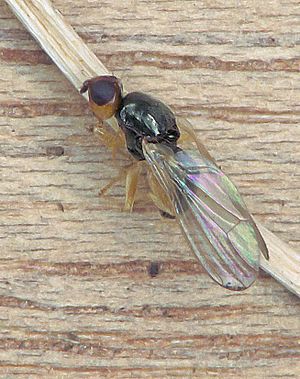Carrot fly facts for kids
Quick facts for kids Carrot fly |
|
|---|---|
 |
|
| Scientific classification | |
| Synonyms | |
The carrot fly (Chamaepsila rosae) is a common garden and farm pest. It mainly harms carrots, but can also attack other plants. These include parsnips, parsley, and celery. It belongs to the family Psilidae, which is a group of flies.
Contents
What Does a Carrot Fly Larva Look Like?
The damage to plants is caused by the carrot fly's larvae. Larvae are the young, worm-like stage of an insect. These larvae are creamy-yellow and look like small maggots. They do not have legs.
They can grow up to 10 millimeters (about 0.4 inches) long. The larvae feed on the outer parts of the carrot root. In autumn, they might dig deeper into the root.
How to Spot Carrot Fly Damage
If your plants are affected by carrot flies, you might see some signs. The leaves of the plant can start to wilt. They may also change color. Often, leaves turn a rusty red or scarlet color. Some yellowing might also appear.
If you pull up the carrots, you might see rusty-brown tunnels. These tunnels are just under the outer skin of the mature roots. This is a clear sign that carrot fly larvae have been feeding.
How to Protect Your Plants from Carrot Flies
Carrot flies lay their eggs in the soil around growing carrots. Once the larvae hatch, they burrow into the carrot roots. Female carrot flies fly very low to the ground. This fact helps gardeners protect their crops.
Here are some ways to stop carrot flies:
- Build a Barrier: You can put up a barrier around your carrot patch. This barrier should be at least 2 feet (60 cm) high. Since the flies fly low, they cannot get over it.
- Use Fleece Covers: A special fabric called horticultural fleece can cover your plants. It acts like a blanket, keeping the flies out.
- Plant Smelly Companions: Carrot flies are attracted to the smell of carrots. You can plant other strong-smelling plants nearby. Onions, chives, and garlic can hide the smell of carrots. This makes it harder for the flies to find their target.
- Mix Your Crops: Planting different types of crops together can confuse the flies. This makes it harder for them to find large groups of carrots.
- Use Deterrent Plants: Some plants naturally keep carrot flies away. Rosemary, sage, and marigolds are good choices.
- Choose Resistant Carrots: Some new types of carrots are bred to resist carrot flies. Look for varieties like "Flyaway" at your garden center.
- Fine Mesh Netting: You can buy very fine plastic mesh netting. This netting can be used to create a wall or a full "cage" around your plants. You will need a frame to support the netting. Make sure the bottom of the netting touches the soil or is buried slightly. This stops the maggots from crawling under it.
- Beneficial Nematodes: You can buy tiny, helpful worms called nematodes (Steinernema species). You apply them to the soil around your carrots. These nematodes will then infect and kill the harmful carrot fly larvae.
The Scientific Name of the Carrot Fly
The scientific name for the carrot fly is Chamaepsila rosae. This name was given by a scientist named Fabricius in 1794. For a while, there was some confusion with another insect that had a similar name. However, in 2006, a special group of scientists decided to keep the name Chamaepsila rosae for the carrot fly. This helps everyone know exactly which insect they are talking about.

